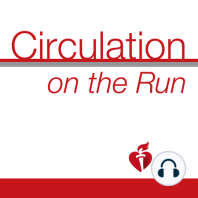20 min listen
Circulation August 18, 2020 Issue
ratings:
Length:
25 minutes
Released:
Aug 17, 2020
Format:
Podcast episode
Description
This week’s episode of Circulation on the Run features author Ami Aronheim and Associate Editor Thomas Eschenhagen as they discuss early cardiac remodeling that promotes tumor growth and metastasis. Dr Carolyn Lam: Welcome to Circulation on the Run, your weekly podcast summary and backstage pass to the journal and its editors. I'm Dr Carolyn Lam, associate editor of the National Heart Center and Duke National University of Singapore. Dr Greg Hundley: And I'm Dr Greg Hundley, associate editor and director of the Pauley Heart Center at VCU Health in Richmond, Virginia. Dr Carolyn Lam: Greg, today we're taking a look at the cardio-oncology world in our feature discussion, but in a very interesting reverse way. Cardio-oncology, what would you think of? I suppose the effects on the heart of cardiotoxic drugs that we use in oncology, right? But this feature paper looks at it the other way around and says does the heart and its remodeling promote tumor growth and cancer? Terribly interesting data coming right up after we discuss a couple of papers, well, all the papers in today's issue. So I want to start. Greg, do you remember what parasites are and why they're important? Dr Greg Hundley: Well, Carolyn, this is actually one of the things that I do remember because we study the parasites when we're looking at microcirculatory dysfunction after the administration of potentially cardiotoxic agents for treatment of cancer. But how about you tell us a little bit more. Dr Carolyn Lam: This is going to be very basic just for all of us. Now, the blood vessels are composed of endothelial cells and mural cells. Endothelial cells line the vascular lumen. Whereas the mural cells, which include faster smooth muscle cells and parasites adhere to the abluminal surface of the endothelium. Parasites regulate vessels stabilization and function, and their loss has been associated in diseases such as diabetic retinopathy, vascular malformation, stroke, and cancer. Just like you said, Greg. Now here we have a series of elegant experiments by Dr Mariona Graupera from IDIBELL in Barcelona and colleagues who use genetic mouse models to identify the specific molecular signature of mural cells at early and late stages of the energetic process and unveil their biological relevance. Their results show that phosphatidyl inositol 3-kinase or PI3K-beta is the main regulator of parasite, proliferation and maturation in vessel growth. PI3K-beta deletion in parasites triggered early parasite maturation, whereas exacerbated PI3K signaling delayed parasite maturation, and thus vessel maturation during angiogenesis. Dr Greg Hundley: So clinically what's the take home message here. Dr Carolyn Lam: The proposed model of mural cell maturation together with the tools developed would be instrumental for the characterization of mural cells in pathologies associated with deregulated vessel growth, such as ischemia stroke, vascular malformation, diabetic retinopathy, and cancer. The therapeutic potential of modulating parasite biology through PI3K signaling provides a new window of clinical intervention for vascular related diseases in which parasite dysfunction contributes to their onset and or progression. Dr Greg Hundley: Very nice, a very important cell type Carolyn. Well, my paper comes from Professor Xiang Qian Lao from The Chinese University of Hong Kong. In this paper, the authors investigated in 140,072 adults all greater than the age of 18, without hypertension who joined a standard medical screening program with 360,905 medical exams that occurred between the years of 2001 and 2016. They assess the joint associations of habitual physical activity and long-term exposure to find particulate matter with the development of hypertension in Taiwan. Dr Carolyn Lam: Wow. A huge study. So what did they find Greg? Dr Greg Hundley: After adjusting for a wide range of co-variants including a mutual adjustment for physical activity or particulate matter, a higher physical activi
Released:
Aug 17, 2020
Format:
Podcast episode
Titles in the series (100)
Circulation December 19/26, 2017 Issue: Circulation Weekly: Your Weekly Summary & Backstage Pass To The Journal by Circulation on the Run
